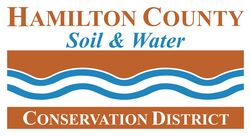Invasive Species
|
The SWCD is addressing invasive via the development of the Hamilton County Invasives Partnership. This group is a collaborative of public and private landowners and managers in the county and other interested individuals, businesses, and organizations who are working together to address invasive species in a holistic way. Please check out the latest invasive species info, events and trainings on our HIP webpage.
|
What are invasive species?
As long as humans have traveled across the earth, they have purposefully and sometimes unknowingly transported plants, animals, insects, and other organisms on their bodies, in shipping containers, on their shoes, etc. When an organism is brought to an area it did not traditionally grow, it is considered non-native. When a non-native species causes harm to the environment, human health, and the economy, it is considered an invasive species.
Why are they a problem?
Some of these exotic species, when uninhibited by the environmental conditions and predators of their natural home, are able to feed, reproduce, and spread with no limitations. These species "invade" and spread, sometimes causing great environmental destruction in their path. The proliferation of invasive species in an ecosystem disrupts the complex and critical relationships that our native species have with their physical environment and other organisms.
How do I know if I have invasive species on my property?
Resources are available on this page and elsewhere online that can help you identify invasive species and suggest removal options. Alternatively, feel free to contact our office for a consultation.
What can I do if I have invasive species on my property?
Removal methods for invasive species vary widely depending on their reproduction and ecology and unfortunately, it takes maintenance to keep invasive species from recolonizing an area. Establishing native species after removal can help keep invasives at bay. Refer to the resources on the right for more info.
If you'd rather hire out services for invasive removal, refer to this Grow Indiana Natives list of invasive plant removal contractors.
As long as humans have traveled across the earth, they have purposefully and sometimes unknowingly transported plants, animals, insects, and other organisms on their bodies, in shipping containers, on their shoes, etc. When an organism is brought to an area it did not traditionally grow, it is considered non-native. When a non-native species causes harm to the environment, human health, and the economy, it is considered an invasive species.
Why are they a problem?
Some of these exotic species, when uninhibited by the environmental conditions and predators of their natural home, are able to feed, reproduce, and spread with no limitations. These species "invade" and spread, sometimes causing great environmental destruction in their path. The proliferation of invasive species in an ecosystem disrupts the complex and critical relationships that our native species have with their physical environment and other organisms.
How do I know if I have invasive species on my property?
Resources are available on this page and elsewhere online that can help you identify invasive species and suggest removal options. Alternatively, feel free to contact our office for a consultation.
What can I do if I have invasive species on my property?
Removal methods for invasive species vary widely depending on their reproduction and ecology and unfortunately, it takes maintenance to keep invasive species from recolonizing an area. Establishing native species after removal can help keep invasives at bay. Refer to the resources on the right for more info.
If you'd rather hire out services for invasive removal, refer to this Grow Indiana Natives list of invasive plant removal contractors.
Invasive species cost the US over $138 billion per year.

